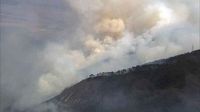On March 24, 2025, wildfires erupted across South Korea, igniting simultaneous blazes in over 40 locations. This widespread disaster has struck particularly hard due to adverse weather conditions marked by high temperatures and strong winds. The fires are reminiscent of past devastating events in Korean history, including the 2019 Gangneung-Samcheok wildfire and the 2023 Sokcho-Goseong wildfire, both of which also occurred during the spring months.
The current wildfire outbreak has intensified rapidly, primarily influenced by the meteorological conditions prevailing during the time. A high-pressure system located in southern Korea has been intensifying alongside a lower pressure system to the north. This development has generated strong westerly winds that exacerbate fire spread, leading to concerns over containment efforts. According to the National Forest Research Institute’s wildfire research division, “The major characteristic of this large-scale wildfire is the extreme temperatures reminiscent of early summer, combined with strong westerly winds that promote rapid spread and carry embers over long distances.” Indeed, in recent experiments, winds at 6m/s have increased fire spread rates up to 26 times faster than normal conditions.
Data illustrates just how significant the impact of wind can be; a 2-meter length of tinder takes 7 minutes to incinerate without wind. However, when subjected to 6m/s winds, that same length is consumed in a mere 16 seconds. This remarkable speed in which fire spreads underscores the dangers posed by flying embers, which can leap across hundreds of meters, making firefighting efforts particularly challenging. Current conditions exacerbate this risk; as reported by local officials, the average temperature reached over 27 degrees Celsius in Onyang-eup, Ulju-gun, where some of the fires have broken out.
Adding to these challenges, the East Coast of Korea has experienced a rise in average temperatures, contributing to what feels like early summer weather. Observations reveal alarming trends: of the average 546 wildfires that occur annually, more than half (303) have taken place between March and May over the past decade. These findings indicate a rising wildfire risk associated with changing weather patterns.
Local fire services are currently grappling with containing these wildfires, a task made ever more difficult by adverse weather conditions. According to reports, the Korea Forest Service is working tirelessly to manage the fires, but their efforts face challenges from the strong winds and high temperatures that continue to persist. On March 23, 2025, strong gusts made extinguishing efforts in the Yeongnam region incredibly arduous as they struggled to rein in the blazes.
Wind conditions have not improved significantly; while areas like Uiseong reported relatively weak winds, others like Sangcheong and Ulju have experienced maximum instantaneous wind speeds of 8.3m/s and 10.4m/s, respectively. The persistent 'south high, north low' pressure pattern is primarily responsible for these windy conditions. According to weather forecasts, today is expected to see even stronger gusts across the country, particularly in mountainous regions where winds could achieve speeds of 20m/s.
The Korea Meteorological Administration indicates that a brief respite from the dry conditions may occur around Thursday, with potential rain forecasted. However, the anticipated amount is less than 1mm, which will likely be insufficient in alleviating the dire situation. Warnings are also in effect in regions like Daegu, Gyeongsan, Gyeongbuk's east coast, northern Gyeongsangnam-do, and the east coast of Gangwon due to the extremely dry weather conditions. Unfortunately, precautions remain vital as a momentary lapse in attention could lead to catastrophic wildfires.
This wildfire crisis has underscored the dire need for increased vigilance in fire management and environmental awareness. The overlapping occurrences of high temperatures and dry winds emphasize the importance of addressing the underlying causes of these increasingly frequent wildfires—preventing small sparks from turning into widespread disasters.
As South Korea grapples with these wildfires, officials urge residents to remain cautious and prepared. The country’s wildfire season, marked by rising temperatures and extended dry spells, poses high risks, and residents are reminded to manage any potential fire hazards responsibly. With the increasing frequency and intensity of such disasters, the nation must adopt better prevention strategies to minimize fire risks in the future.

![[오늘 날씨] 더 거센 돌풍 예고…산불 재확산 우려](https://thumbor.evrimagaci.org/kORR9jFWCAuc4LI7A96mRDm577o=/200x0/tpg%2Fsources%2Fdc20f3c6-cdb7-4601-8cb8-0f1a7c346094.jpeg)



